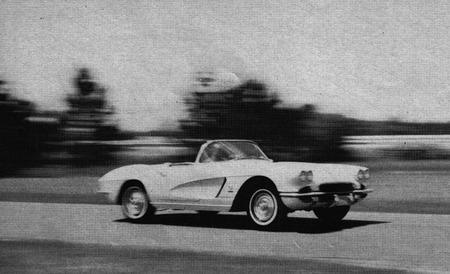As always, the fuel-injected Corvette engine is a sweetheart to drive. Power is excellent, but even more impressive is the torque curve, which is as close to being flat as any we’ve seen. From its 4000 rpm peak it falls off only 20 pound-feet at the extremes of peak power (6000) and 2000 rpm. In action this engine delivers such constant thrust without surges or flat spots that the feel of acceleration is deceptively docile. The figures prove that performance is much like last year’s f.i. Corvette (SCI, December, 1960) up to 80, above which the new one just continues to soar. Though the time to 80 is unchanged, time to 100 is cut from 18.0 to 16.6 seconds. Quarter-mile time is improved from 15.6 to 15.0 seconds, though the terminal speed is up only one mph to 95 — not bad for a stocker!
With two aboard, normal tires, no positraction and a 3.70 axle, this Corvette was highly standard. The added power is such that once again rear-axle bounce is a problem on standing starts, in spite of the torque arms above the axle, so the times to low and medium speeds can’t show improvement in proportion to the new output. Though the new engine’s red-line is 6300 (down 200 rpm from last year), experienced Corvette test driver Bob Clift recommended that we shift up at 5600 rpm for best results over the quarter-mile. His tests have shown that rotating inertia forces above 5600 are such that the extra revs cost more power than they produce, in terms of acceleration. Top speed would be another matter, of course.
When we jumped out of this injected bombshell into the basic Powerglide Corvette, we expected quite a comedown in performance; we were amazed at how little difference there was. Sixty in 8.8 seconds and the quarter-mile in 16.8 is, after all, not waiting around. Doing this by merely stepping down and holding on offers its own peculiar pleasure, as the solid V8 bites into higher and higher speeds with its distinctive hard, metallic wail. As a comfortable cross-country tourer, the Powerglide Corvette offers a high pleasure quotient.
During our acceleration tests of the Powerglide car it was shifting up at 4500 rpm instead of the specified 47-4800 (tach red-line is 5500), but holding it longer in the lower cog didn’t change the times significantly. It makes that shift at about 58 mph, automatically under full throttle, and kickdown can be obtained at any speed up to about 47 mph. Just easing away from a standing start with light throttle, it drops into high at 14 mph. There is some creep at a standstill, though no more than is usual nowadays.
A downshift can be initiated by moving the floor-mounted control lever, but it’s not the smoothest operation for braking purposes and the single low ratio isn’t actually usable in the speeds where engine braking is most helpful. Thus we don’t feel there’s much to be gained by downshifting the box to slow down. This does give the brakes a lot of work, but even the standard Corvette binders are remarkably durable these days. For the sake of retaining maximum control, even on the highway, we feel most Corvette buyers will want one of the hand-shifted transmissions, but we’d suggest consideration of the Powerglide for a unique marriage of sports car handling and go with touring car convenience.


Leave a Reply